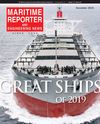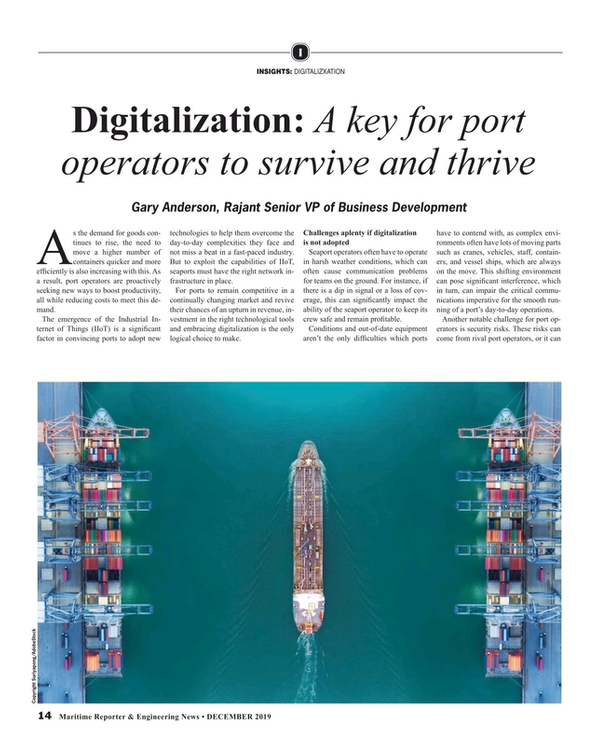
Digitalization Key for Port Operators to Survive and Thrive
As the demand for goods continues to rise, the need to move a higher number of containers quicker and more efficiently is also increasing with this. As a result, port operators are proactively seeking new ways to boost productivity, all while reducing costs to meet this demand.
The emergence of the Industrial Internet of Things (IIoT) is a significant factor in convincing ports to adopt new technologies to help them overcome the day-to-day complexities they face and not miss a beat in a fast-paced industry. But to exploit the capabilities of IIoT, seaports must have the right network infrastructure in place.
For ports to remain competitive in a continually changing market and revive their chances of an upturn in revenue, investment in the right technological tools and embracing digitalization is the only logical choice to make.
Challenges aplenty if digitalization is not adopted
Seaport operators often have to operate in harsh weather conditions, which can often cause communication problems for teams on the ground. For instance, if there is a dip in signal or a loss of coverage, this can significantly impact the ability of the seaport operator to keep its crew safe and remain profitable.
Conditions and out-of-date equipment aren’t the only difficulties which ports have to contend with, as complex environments often have lots of moving parts such as cranes, vehicles, staff, containers, and vessel ships, which are always on the move. This shifting environment can pose significant interference, which in turn, can impair the critical communications imperative for the smooth running of a port’s day-to-day operations.
Another notable challenge for port operators is security risks. These risks can come from rival port operators, or it can be in the form of something far more sinister, such as terrorist groups. For example, seaport competitors may deploy drones to disrupt operations, or even spy and gain intelligence about its business logistics. However, terrorism can potentially target a specific port, which would catastrophically affect the valuable exporting and porting process of the business. Furthermore, this could possibly impair and destabilize a nation’s economy. If seaport operators don’t embrace digitalization, they are at risk of being left with legacy infrastructure, which will only hinder their growth and prevent them from scaling their operations in the future. However, each port is different, meaning each one has its own vast and varying complex needs, which makes the challenge of delivering and implementing multiple communication networks a problematic task. That’s where Rajant’s Kinetic Mesh technology can offer a solution.
Liberating operations
Seaports handle millions of containers every day, meaning guaranteed, secure, and reliable connectivity is a necessity. Rajant’s Kinetic Mesh delivers the robust connectivity which port operators demand to take full advantage of IIoT. By deploying Rajant’s ruggedized multi-radio BreadCrumb nodes equipped with InstaMesh networking software onto autonomous equipment, operators can communicate and control their assets, whether they are stationary or on the move.
With ports operating across a vast area, it can be challenging to monitor all their assets at once. Still, with Rajant’s comprehensive tracking ability of containers, vehicles, and staff, it can provide port operators with the unparalleled real-time tracking capabilities to function as effectively as possible. Rajant’s technology allows a business to hold multiple connections at any time and the ability to scan the environment to decipher the fastest route from source to destination and maximize efficiency.
The fourth industrial revolution is helping to create seamless, autonomous production processes across a host of sectors and in particular, allowing ports to have increased security measures in place, whether that be via cameras on the ground or UGVs or drones in the sky. Security is fundamental to ensure a seaport can operate effortlessly, without any disruptions. If not, it has the potential to cause a lull in efficiency levels for port operators. Furthermore, Rajant’s Kinetic Mesh network offers robust security capabilities, ensuring that port operators can protect their critical data. The network has extreme ruggedness and is proven to support AES-CCMP and TKIP encryption with configurable per-hop, per-packet authentication.
Ports are historically demanding environments, with stacks of containers acting as barriers and interfering with the communication signals. However, Rajant’s BreadCrumbs, and their ability to communicate peer-to-peer, via multiple simultaneous connections, means that information can be shared back and forth in a fully mobile, highly resilient web of communications. Furthermore, the BreadCrumbs can maintain these connections, even while in motion, and autonomously make additional connections to other nodes as they come into range.
By adapting to obstacles in the network, Rajant’s dynamic technology can deliver robust, mobile-enabled connectivity ports need to capitalize on the opportunities of IIoT fully.
How Rajant helped connect DP World Antwerp
In partnership with BT, Rajant helped deliver a wireless backbone solution for DP World Antwerp in Belgium, for its Antwerp Gateway. As one of the busiest container terminals in Europe, it handles two-and-a-half million containers every year. With 900 staff, 3000 trucks, and 950 ships operating at the port, it required an intelligent, rock-solid IoT infrastructure to support its growing operations.
Ensuring end-to-end reliable and secure wireless connectivity across DP World Antwerp would be no easy feat due to the vast environmental interference across the port. Thanks to its proven track record in serving industrial environments, Rajant’s wireless Mesh technology was chosen by BT to help meet DP World Antwerp’s complex demands. Rajant’s “Make-Make-Make-Never-Break” method of forming connections ensured DP World had a solution to its interference challenges.
Rajant’s BreadCrumb nodes were able to create an intricate, and robust set of frequencies which could send and retrieve signals, while continuously shifting to provide the best route for the signal. Therefore, if a certain path became unavailable, or an object is obstructing the path, the nodes can identify an alternative route to redirect the data. This means that the network can dynamically adapt connections to moving vehicles such as containers or large ships, meaning that DP World Antwerp never falls behind.
Additionally, DP World will be able to analyze and optimize processes such as the movement of vehicles across the site – providing operators across the port with an end-to-end view of its operations to enable timely analysis and improved decision making.
Digitalization the key to unlocking the vast potential
It is clear as the port industry continues to move further into the 21st century, that demands will not stutter but only increase exponentially in the future. With the increased pressures that port operators face day-to-day, it becomes not only a case of keeping up with the demand but also of survival.
The proliferation of the IoT has provided ports with a stellar opportunity to thrive and utilize technology to digitally transform their ports and day-to-day operations – providing them with the tools to enhance their performance and monetize on new revenue-generating opportunities.
| Gary Anderson is Rajant Senior VP of Business Development |
Read Digitalization Key for Port Operators to Survive and Thrive in Pdf, Flash or Html5 edition of December 2019 Maritime Reporter


